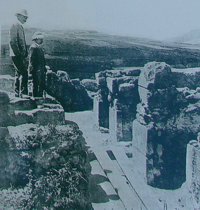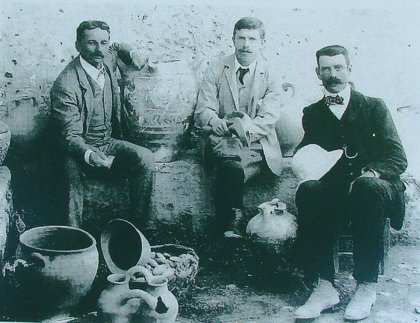Excavations first took place at Knossos in 1878 when an antiquarian businessman from Heraklion,
Minos Kalokairinos, uncovered part of the West Wing of the Palace.
In 1898, a law on archaeology drafted by the newly-founded Cretan State created the right conditions for systematic excavations that began in March 1900 under
Arthur Evans, then Director of the Ashmolean Museum in Oxford. Two years later, the excavation of the Palace had almost been completed. In the years that followed, supplementary research was carried out, which came to an end in 1930-31.

Evans' most important colleagues were the archaeologist D. Mackenzie, known for his excavation in Melos, who undertook to keep the excavation journal, and the architects C.Doll, F.G. Newton and Piet de Jong, the artists Gillieron pere et fils and the archaeologists D. G. Hogarth, A. Wace, E.J. Forsdyke and J. Pendlebury.
Evans and his staff were originally based in the house of a Turkish bey near the Palace, while the villa Ariadne was built in 1906 according to Doll's plans.

Evans with the architect Th. Fyfe and the archaeologist D. Mackenzie
After World War 2 the British School of Archeology continued the excavations with important results in the palace and the surrounding Minoan town.
The need for conservation of the Palace was obvious from the first years of excavation. The fragile materials with which it is built have proved particularly susceptible to weathering. During the first phase of their restoration attempts in 1905, Evans and his colleagues confined themselves to protecting the ruins. However, after 1925, Evans tried a radical reconstruction of the monument using concrete on large scale. Floors and whole architectural units were reconstructed. Wooden beams and wooden Minoan columns were made of reinforced concrete and rendered with paint. The wall paintings were restored and copies set up at different points.
Evans interventions produced a variety of reactions. It has been observed that the archaeological evidence is sometimes insufficient to support reconstruction. In other cases, the ancient remains are not clearly differentiated from modern intervention. The reconstructions were necessary for the protection of the monument. Moreover, they capture the interest of the visitors and help them appreciate the architecture of the Palace better. Others, nonetheless, think that, to a great extent, the reconstruction impose Evans's ideas as well as the prevailing aesthetics and ideological tendencies of his age on the visitors. But today, Evan's reconstruction of the Palace is an inextricable part of the monument and its history.
After World War 2, extensive restoration of the palace took place under the directors of Heraklion Museum, N. Platon and S. Alexiou. The works, however, were limited to conserving ancient walling, consolidating floors and protecting certain areas with roofing. During the nineties a great part of the concrete fabric of the Palace was conserved under the authority of the Directorate for the Restoration of ancient Monuments and the 23d Ephorate of Antiquities.
From 1996 onwards, the project "Conservation - consolidation - promotion of the Palace and archaeological site of Knossos" began, sponsored by the Ministry of Culture and administered by the "Funds for Administration of the Credits for Execution of Archaeological Works".